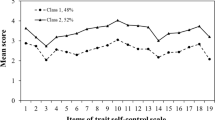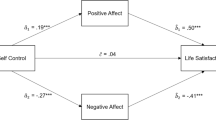Abstract
Well-being is a multidimensional construct which includes hedonic and eudaimonic aspects. Hedonic well-being is focused on happiness, while eudaimonic well-being is focused on developing of human potential. Most hedonic psychologists have used measures of subjective well-being (SWB), which have two components: a cognitive evaluation of the satisfaction with one’s life as a whole, and an affective component that refers to predominance of positive over negative affect (or affect balance). Eudaimonic well-being, sometimes labelled psychological well-being (PWB), includes subjective evaluations of effective psychological functioning. Ryff’s (1989a) model of PWB, which is included within the eudaimonic perspective, conceives well-being as a multidimensional construct made up of life attitudes like self-acceptance, positive relation with others, autonomy, environmental mastery, purpose in life, and personal growth. Research has revealed that SWB and PWB are related, but, they are also distinguishable, since they were differentially related to various criteria. The main goal of the present study was to explore how these two different aspects of well-being are related. Two hundred and fifty-five individuals (114 male and 141 female, mean age = 36.46, standard deviation = 10.83) participated in the study. All the components of well-being were strongly interrelated, and mediational analysis showed that affect balance mediated the relationships between some positive life attitudes and satisfaction with life. Future research, using longitudinal designs, should clearly establish the causal relationships between the different aspects of well-being.


Similar content being viewed by others
References
Allport, G. (1961). Pattern and growth in personality. New York: Holt, Rinehart & Winston.
Baron, R., & Kenny, D. (1986). The moderator-mediator variable distinction in social psychological research: Conceptual, strategic, and statistical considerations. Journal of Personality and Social Psychology, 51, 1173–1182.
Bradburn, N. (1969). The structure of psychological well-being. Chicago: Aldine.
Cabañero, M. J., Richart, M., Cabrero, J., Orts, M. I., Reig, A., & Tosal, B. (2004). Reliability and validity of satisfaction with life scale in a sample of pregnant women. Psicothema, 16, 448–455.
Chamberlain, J., & Haaga, D. (2001). Unconditional self-acceptance and psychological health. Journal of Rational Emotive and Cognitive Behavior Therapy, 19, 163–176.
Compton, W. (1998). Measures of mental health and a five factor theory of personality. Psychological Reports, 83, 371–381.
Compton, W., Smith, M., Cornish, K., & Qualls, D. (1996). Factor structure of mental heath measures. Journal of Personality and Social Psychology, 71, 406–413.
Deaton, A. (2008). Income, health, and well-being around the world: Evidence from the Gallup World Poll. Journal of Economic Perspectives, 22, 53–72.
Deci, E., & Ryan, R. (2008). Hedonia, eudaimonia, and well-being: An introduction. Journal of Happiness Studies, 9, 1–11.
Díaz, D., Rodríguez-Carvajal, R., Blanco, A., Moreno-Jiménez, B., Gallardo, I., Valle, C., et al. (2006). Spanish adaptation of Ryff’s scales of psychological well-being. Psicothema, 18, 572–577.
Diener, E. (2000). Subjective well-being. The science of happiness and proposal for a national index. American Psychologist, 55, 34–43.
Diener, E., Lucas, R., & Oishi, S. (2002). Subjective well-being: The science of happiness and life satisfaction. In C. R. Snyder & S. J. Lopez (Eds.), Handbook of positive psychology (pp. 63–73). New York: Oxford University Press.
Heine, S. J., Kitayama, S., Lehman, D. R., Takata, T., Ide, E., Leung, C., et al. (2001). Divergent consequences of success and failure in Japan and North America: An investigation of self-improving motivations and malleable selves. Journal of Personality and Social Psychology, 81, 599–615.
Holmbeck, G. (2002). Pos-hoc probing of significant moderation and mediational effects in studies of pediatric populations. Journal of Pediatric Psychology, 27, 87–96.
Kafka, G., & Kozma, A. (2002). The construct validity of Ryff’s scales of psychological well-being (SPWB) and their relationship to measures of subjective well-being. Social Indicator Research, 57, 171–190.
Keyes, C., Shmotkin, D., & Ryff, C. (2002). Optimizing well-being: The empirical encounter of two traditions. Journal of Personality and Social Psychology, 82, 1007–1022.
Maslow, A. (1968). Toward a psychology of being. New York: Van Nostrand.
McGregor, I., & Little, B. (1998). Personal projects, happiness, and meaning: On doing well and being yourself. Journal of Personality and Social Psychology, 74, 494–512.
Myers, D. G. (2000). The funds, friends, and faith of happy people. American Psychologist, 55, 56–67.
Pavot, W., & Diener, E. (1993). Review of the satisfaction with life scale. Psychological Assessment, 5, 164–172.
Rogers, C. (1961). On becoming a person. Boston: Houghton Mifflin.
Rojas, M. (2006). Life satisfaction and satisfaction in domains: Is it a simple relationship? Journal of Happiness Studies, 7, 467–497.
Ryan, R., & Deci, E. (2001). On happiness and human potentials: A review of research on hedonic and eudaimonic well-being. Annual Review of Psychology, 52, 141–166.
Ryan, R., & Deci, E. (2002). An overview of self-determination theory: An organismic-dialectical perspective. In E. Deci & R. Ryan (Eds.), Handbook of self-determination research (pp. 3–33). Rochester, NY: The University of Rochester Press.
Ryan, R., Huta, V., & Deci, E. (2008). Living well: A self-determination theory perspective on eudaimonina. Journal of Happiness Studies, 9, 139–170.
Ryff, C. (1989a). Beyond Ponce de León and life satisfaction. New directions in quest of successful aging. International Journal of Behavioral Development, 12, 35–55.
Ryff, C. (1989b). Happiness is everything, or is it? Explorations of the meaning of psychological well-being. Journal of Personality and Social Psychology, 57, 1069–1081.
Ryff, C., & Keyes, C. (1995). The structure of psychological well-being revisited. Journal of Personality and Social Psychology, 69, 719–727.
Ryff, C., & Singer, B. (2008). Know thyself and become what you are: A eudaimonic approach to psychological well-being. Journal of Happiness Studies, 9, 13–39.
Sandin, B., Chorot, P., Lostao, L., Joiner, T. E., Santed, M. A., & Valiente, R. M. (1999). Positive and Negative Affect Scales (PANAS): Factorial validity and cross-cultural convergence. Psicothema, 11, 37–51.
Schimmack, U., & Diener, E. (1997). Affect intensity: Separating intensity and frequency in repeatedly measured affect. Journal of Personality and Social Psychology, 73, 1313–1329.
Schwarz, N., & Clore, G. (1983). Moos misattribution, and judgments of well-being: Informative and directive functions of affective states. Journal of Personality and Social Psychology, 45, 513–523.
Schwarz, N., & Clore, G. (2007). Feelings and phenomenological experiences. In E. Higgins & A. Kruglanski (Eds.), Social psychology: Handbook of basic principles (pp. 385–407). New York: Guilford Press.
Sobel, M. (1988). Direct and indirect effects in linear structural equation models. In J. Long (Ed.), Common problem/proper solutions: Avoiding error in quantitative research (pp. 46–64). Beverly Hills, CA: Sage.
Waterman, A. S. (2007). Doing well: The relationships of identity status to three conceptions of well-being. Identity: An International Journal of Theory and Research, 7, 289–307.
Waterman, A. S., Schwartz, S. J., & Conti, R. (2008). The implications of two conceptions of happiness (hedonic enjoyment and eudaimonia) for the understanding of intrinsic motivation. Journal of Happiness Studies, 9, 41–79.
Watson, D., Clark, L. A., & Tellegen, A. (1988). Development and validation of brief measures of positive and negative affect. The PANAS scales. Journal of Personality and Social Psychology, 54, 1063–1070.
Author information
Authors and Affiliations
Corresponding author
Rights and permissions
About this article
Cite this article
Sanjuán, P. Affect Balance as Mediating Variable Between Effective Psychological Functioning and Satisfaction with Life. J Happiness Stud 12, 373–384 (2011). https://doi.org/10.1007/s10902-010-9199-5
Published:
Issue Date:
DOI: https://doi.org/10.1007/s10902-010-9199-5




